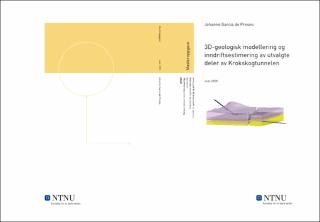| dc.contributor.advisor | Grøv, Eivind | |
| dc.contributor.advisor | Ellefmo, Steinar Løve | |
| dc.contributor.author | Presno, Johanne Garcia de | |
| dc.date.accessioned | 2021-09-24T17:38:50Z | |
| dc.date.available | 2021-09-24T17:38:50Z | |
| dc.date.issued | 2020 | |
| dc.identifier | no.ntnu:inspera:54979149:51131572 | |
| dc.identifier.uri | https://hdl.handle.net/11250/2781559 | |
| dc.description.abstract | På veien mot en papirløs arbeidsplass spiller BIM-modellering en sentral rolle. En 3D-geologisk modell over antatt bergmassefordeling mot dypet er et av elementene som er vanlig å inkludere i en BIM-modell. I denne masteroppgaven er en 3D-geologisk modell blitt laget i planleggingsfasen av et prosjekt.
Ringeriksbanen er en dobbeltsporet jernbanelinje mellom Sandvika og Hønefoss med planlagt byggestart er i 2021/2022. Den er en del av InterCity-satsingen, og vil korte ned reisetiden på Bergensbanen med 1 time. Krokskogtunnelen utgjør ca. 23 km av Ringeriksbanen. Formålet med denne masteroppgaven har vært å estimere inndrift for to kortere strekninger av Krokskogtunnelen. Som et verktøy til estimeringen ble to geologiske 3D-modeller laget i Leapfrog Works.
Strekning A er plassert sør i tunnelen, strekning B midt på. Begge har en lengde på 250 m. Modellene er brukt for å finne bergartsfordelingen langs de to strekningene. På bakgrunn av dette ble netto inndrift estimert ved hjelp av programvaren Tunsim. Et mengdeanslag og tidsestimat for de fremdriftshemmende aktivitetene arbeidssikring, utvidelse av tunnelprofilet, forinjeksjon, forbolting, tung sikring og redusert salvelengde er gjort. Brutto inndrift ble dermed funnet ved å summere sammen tiden for netto inndrift og de fremdriftshemmende aktivitetene.
De to 3D-modellene er laget ut ifra kjerneboringer, berggrunnskart, svakhetssoner og terrengmodell. Under modelleringer er forenklingene plane bergartsgrenser, ingen vridning av forkastningsblokker og konstant bredde av svakhetssoner mot dypet blitt gjort. Q-verdiene for de ulike bergmassene benyttet under estimering er vurdert ut ifra 5 kjerneboringer utført langs tunneltraseen.
Modellen til område A sier at 95 m av strekning A går gjennom Askergruppen, 110 m gjennom basalt og 45 m gjennom en svakhetssone av klasse IV. Askergruppen upåvirket av svakhetssonen har en estimert inndrift på 22,85 m/uke, for basalt er den 22,09 m/uke. Svakhetssonen og det påvirkede sideberget har estimert inndrift mellom 1,66 og 3,13 m/uke. Dette gir en total drivetid gjennom strekning A på 62,97 uker. Langs strekning B viser modellen at tunnelen går gjennom 240 m med RP8, og 10 m gjennom en svakhetssone av klasse II. RP8 upåvirket av svakhetssonen har en estimert inndrift på 16,9 m/uke. For svakhetssonen og påvirket sideberg forventes tunnelen å drive 2,04 til 2,08 m/uke. Den totale drivetiden for strekning B blir da 27,64 uker. | |
| dc.description.abstract | With the goal of achieving a workplace without physical papers, BIM is the main tool for reaching this goal. A 3D geological model with the predicted rock mass is one of the elements commonly included in a BIM-model. In this master thesis two 3D geological models have been made at the design stage of a project.
The Ringeriksbanen is a double-track railway between Sandvika and Hønefoss with a planned start of construction in 2021/2022. The railway is a part on the InterCity-project and will reduce the traveling time from Oslo to Bergen with one hour. The Krokskogtunnel amounts to 23 km of the Ringeriksbanen. The mail goal of this master thesis has been to predict the advance rate for two sections of the Krokskogtunnel. Two geological 3D models were made in Leapfrog Works to help predict the advance rate.
Section A is located south in the tunnel, section B in the middle. Both have a length of 250 m. The models have been used to find the rock distribution along both sections. Based on this, the net advance rate was estimated by using a program called Tunsim. A prediction has also been made of the quantity and time of operations inhibiting the advance rate. These are: temporary rock support consisting of bolts and shotcrete, expansion of the tunnel profile, pre-grouting, spiling, heavy rock support and reduced round length. Gross advance rate was found by adding the times for the operation inhibiting the advance rate to the estimated net advance rate.
The 3D models are based on core drillings, map of the bedrock, weakness zones and a 3D model of the terrain. The main simplifications made while modelling were plane rock contacts, no twisting of the fault blocks and constant width of a weakness zone as it descends into the ground. The Q-values were chosen by looking at parameters registered for 5 core drillings done along the future railway.
The model of region A tells us that 95 meters of the tunnel goes through the Askergruppen in section A, 110 m through basalt and 45 m through a weakness zone of class IV. The Askergruppen not influenced by the weakness zone has an estimated gross advance rate of 22.85 m/week. For basalt it is 22.09 m/week. The gross advance rate for the weakness zone and the influenced nearby rock mass is between 1.64 and 3.13 m/week. This gives a total of 62.97 weeks to tunnel through section A. 240 m of section B consists of RP8, 10 m of a weakness zone of class II. The RP8 uninfluenced by the weakness zone has a gross advance rate of 16.9 m/week, whereas the weakness zone itself and the nearby influenced rock mass have an estimated gross advance rate of 2.04 to 2.08 m/week. To tunnel through section B is estimated to take 27.64 weeks. | |
| dc.language | nob | |
| dc.publisher | NTNU | |
| dc.title | 3D-geologisk modellering og inndriftsestimering av utvalgte deler av Krokskogtunnelen | |
| dc.type | Master thesis | |
